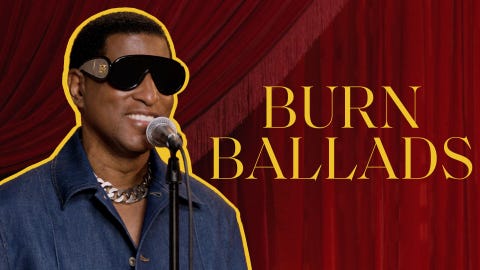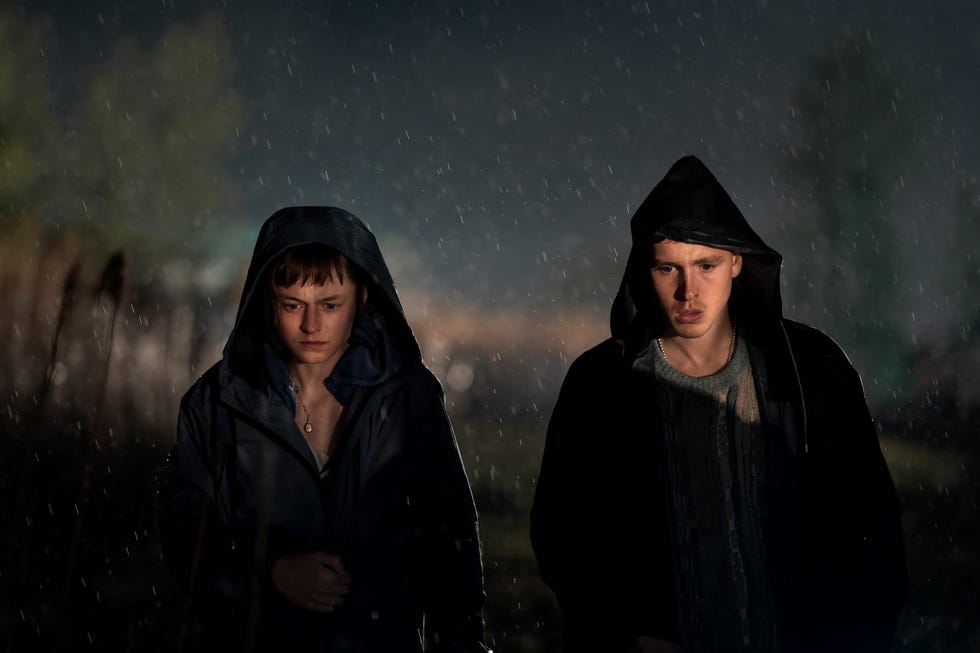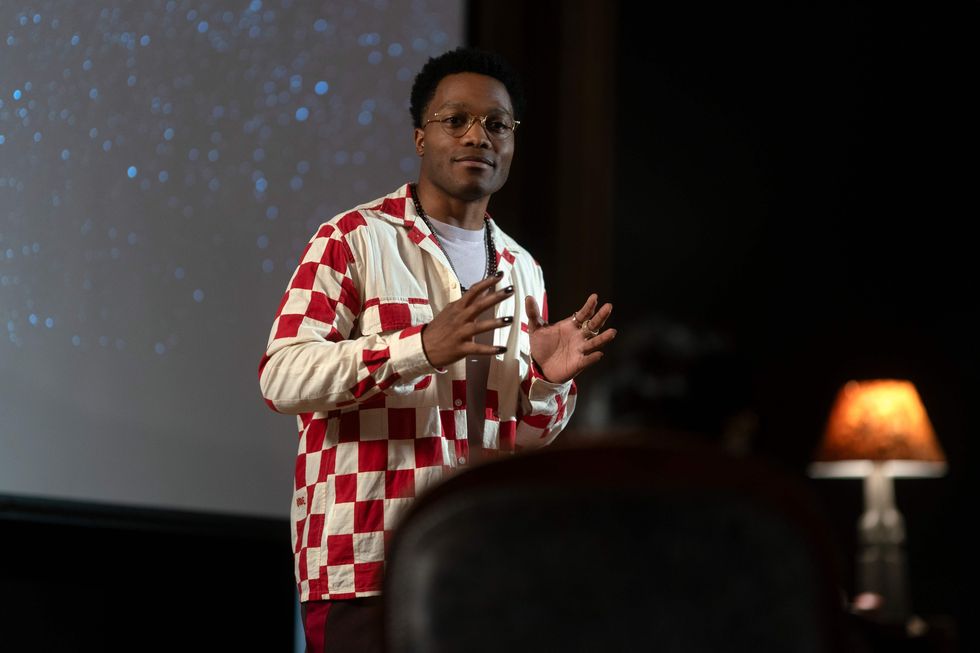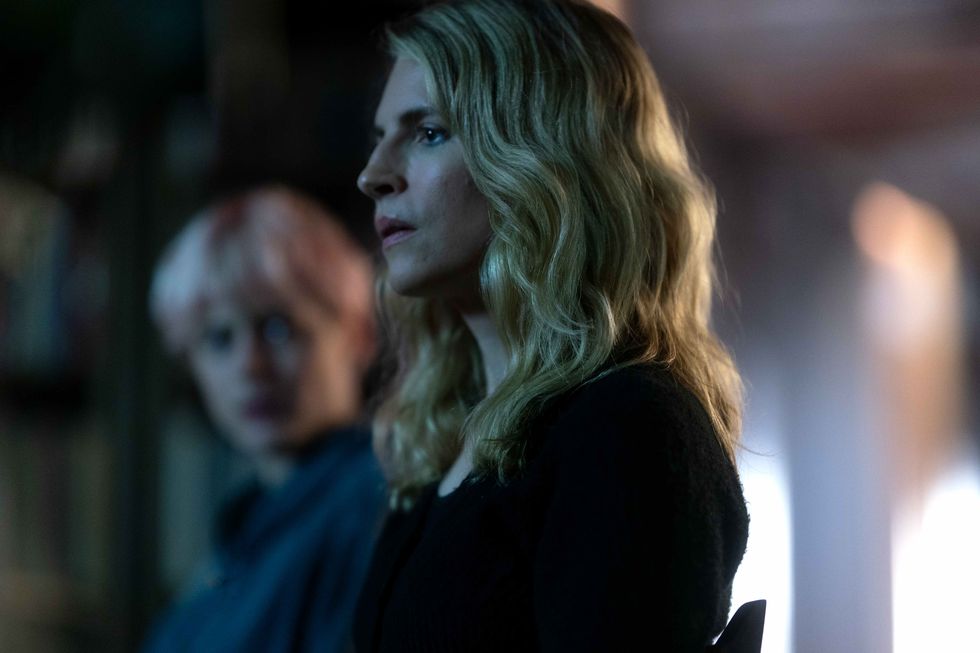With A Murder at the End of the World, Brit Marling Made a Whodunit That Challenges the Status Quo
Spoilers below.
When producer, writer, and actor Brit Marling was creating the new series A Murder at the End of the World, she was partially inspired by Rihanna. Surely, who isn’t? But the former star and co-creator of The OA was especially moved while writing this multifaceted murder mystery, which includes elements of sci-fi, big tech, hacking, extreme wealth, and a coming-of-age love story.
“I think a lot of that Rihanna song, ‘We fell in love in a hopeless place,’” Marling tells ELLE.com. “We never played that song in the show, but I remember playing that song a lot when I was just drawing storyboards or writing.”
More From ELLE

She’s referring to protagonist Darby Hart (Emma Corrin) and Bill Farrah (Harris Dickinson), two amateur sleuths who meet in the dark corners of the internet and fall in love while tracking the cold case of a serial killer. They’re gritty Gen Z punks with wolf cuts and tattoos, road tripping across the American West and breaking into homes to find the remains of victims (usually women) who the authorities gave up on searching. As the years pass, Darby and Bill fall out of touch, but they reunite by surprise as successful young adults—by now, she’s a hacker and author; he’s an artist—on a billionaire’s invite-only retreat in Iceland. But alas, one of the guests winds up dead, and Darby must use her detective skills to prove it was a murder before someone else is killed.
On set, Corrin and Dickinson had “such a genuine chemistry,” says Marling, who also directs and stars as a mysterious hacker Lee Anderson, wife of billionaire Andy Ronson, played by Clive Owen. Marling, a longtime fan, didn’t think Owen was genuinely interested in the role, but when he signed on, he came prepared with “deep character homework” and “the most thoughtful, thorough notes.”
For research, Marling and co-creator Zal Batmanglij scoured Reddit threads, message boards, and the National Missing and Unidentified Persons System. They read books on amateur sleuthing accounts and watched documentaries like I’ll Be Gone in the Dark. But they didn’t expect other parts of the story to reflect reality so accurately. Themes of artificial intelligence that they incorporated into the script would become real-life threats by the time the show would air. Especially in Hollywood, where the writers and actors spent months on strike battling AI usage without fair compensation. “It’s been insane to be inside these strikes and see so much of what we were worrying about just come to pass in the larger community,” Marling says.
Aside from nailing the details of the tech and crime-solving worlds, they had to put some extra care into writing the character of Darby, anticipating the audience’s internalized prejudice. A young woman with a blush pink pixie cut, Darby might not wield the same immediate authority solving crime as an older man, like Hercule Poirot, or Matthew McConaughey and Woody Harrelson’s duo on True Detective, or even the twangy Benoit Blanc. Marling realized “that sometimes there’s a lot more heavy lifting when you’re trying to put someone in a position of authority that hasn’t traditionally, in the history of storytelling, been in a position of authority and isn’t playing a cop.”
But that’s part of the reason why Marling does this. After The OA was canceled on Netflix after two seasons, to the devastation of fans worldwide, she wrote a heartfelt note about creating stories—like her films Sound of My Voice and Another Earth—that bend our reality; stories that are, at their heart, really about freedom. (She elaborated about this in her viral New York Times op-ed, “I Don’t Want to Be the Strong Female Lead.”) It’s about creating a world in which young people like Darby Hart can be respected as fearsome detectives despite their age, gender, and appearance. Murder at the End of the World isn’t just about what happens in hopeless places; it’s also about creating a reality that’s a little more hopeful than our own.
Below, Marling discusses why she wanted to make a whodunit, our relationship with technology, and resisting the status quo.
How long was the idea for this show percolating for you? Was it sometime during The OA or just completely separate?
I guess this idea actually had been in our minds for a couple of years, the desire to do a whodunit, and to use the lens of the whodunit as a way of talking about who’d done it in this world.
I think the whodunit came to popularity for the first time between the First and Second World Wars because I think people at that time were looking around and being like, “Okay, how have we gotten to this place, and who’s responsible?” And so it felt like it was due for another cycle. And I guess if the old seat of power had been the English manor house and all the intrigue that unfolds in there, it felt like the new seat of power is Silicon Valley and technology retreats and the sort of fiefdoms of some of these tech billionaires.
And so we were interested in that world, and we’d heard of stories of people being invited on these far-flung retreats where they don’t know where they’re going, and they don’t know who they’re going with, and it felt like a ripe setting for a mystery.
And then around the same time, I was reading a lot about amateur sleuths and was really interested in how many of them feel like outsiders in their own community, where they’re somehow overlooked by the system. Sometimes it’s cops that are kicked off the force, or a lawyer who’s been disbarred, or a retired high school algebra teacher, or a punk kid, or a housewife who takes care of kids all day and then by night is up in her attic solving crimes on the internet.
There felt something very cool about these sort of people coming together and the internet acting as a portal for creating this kind of community that could potentially solve things that nobody else had been able to solve before. And when we read about some of the cold cases, there are some really powerful stories about cases that have gone unsolved for years, and then a group of people on the internet just put their minds to it, and because amongst them, they can devote more hours to it and, harnessing the power of what they can research online and stuff, they’re able to solve many of these things.
So there’s something about that pairing, the underdog of a young punk kid growing up feeling like an outsider in her community, that kind of person finding themselves on a secretive technology retreat and turning out to be a formidable detective, felt fresh and felt exciting and felt like a way to explore a young female protagonist that we hadn’t really seen before on screen.
You mentioned that the whodunit is kind of a social commentary. We’ve seen that recently it’s an interesting tool to satirize the rich, whether it’s Knives Out or White Lotus. Did you also see it as a tool to shine a light on a bigger issue?
Yeah, and I think also to maybe ask questions that we are asking about the role of technology in all of our lives. I just think about how affected we all have been by the internet and the experience of the internet has changed all our relationships and how we think and what’s valuable. Or my relationship with my smartphone, which is with me all the time, and at this point, feels like it’s an organ, an actual extension of my brain. What are all the beautiful things that have come from that? And then what are the unforeseen consequences of these different technologies as they unpack inside?
I think that was part of it. Also, I think it felt like it would be fun to try to do a kind of Agatha Christie-style whodunit but to try to make it grounded and real, because normally, the medium is a little tongue-in-cheek, because it has to be, because there’s something sort of inherently farfetched about the premise of And Then There Were None or something.
I think we were like, “Is there a way to do that where we could find a way to make it feel very real? Is there a way to make it feel like a genuine kind of thriller?” And I think that the amateur sleuth for us felt like the key to that, because normally, if you’re following a very young female detective, there’s something a little heightened and unreal about it, like Nancy Drew feels slightly pushed. And I think the amateur sleuthdom was an interesting way in, because it’s possible, and I think that this is a very cool thing about Gen Z, that you can have amassed 10,000 hours of experience inside something by the time you’re in your early 20s, because you spent your teens solving cold cases online, which is unprecedented. And so there’s something really exciting about coming to a crime scene and the age and gender that is normally the victim—a young, naked woman, mutilated, dead, covered in blood on the floor, usually eroticized in some way—is now the person that’s animated and alive on the crime scene and solving it with genuine authority.
I wanted to bring up a really interesting connection that I caught in the second episode. Martin is talking about writing a film with the help of AI, which I think is just so funny and timely right now, especially with that being a point of contention in both strikes. Was that coincidental, or had you heard rumblings about it in the industry while you were writing it?
Do you know what’s so crazy? We used to have to explain that to people. We would give people the scripts and they’d be like, “What?” Nobody knew what a large language model was, or ChatGPT had not come out yet when we were writing it three years ago at this point.
Some people even thought it was a little risky that we were making our technology billionaire interested in AI. People were like, “Why not make him interested in going to Mars, or why not this or that?” It was interesting, because it was what we thought would be a far-out direction, and then it all just came to pass while we had written, for instance, deepfakes into the story. A lot of people didn’t know what that was. And then by the time we were editing, you could use a deepfake app to do additional dialogue recording, or ADR.
I mean, that is what the actors’ strike is about, which is, we should not be able to make deepfakes of anybody’s work without compensating everyone involved in making that work. And that’s true on the writing front and the acting front.
Your character, Lee Andersen, is super interesting to me. Was she partially based on any real people?
It’s funny. For better or for worse, we tend not to model people after real people, and we tend not to think of actors when we’re writing, because I noticed that if I do that, I sort of am substituting the actor’s charisma or the real person’s charisma for what I’m writing on the page. And I end up not being able to create as robust of a character.
We try to do research on worlds but to try to leave it for the character to come alive on the page itself. And we had our friend, Moxie Marlinspike, who built the app Signal. It’s like an end-to-end encrypted messaging system. We learned a lot from him about that early hacker world that Bill and Darby are also a part of, which has a real community online.
There’s a line in chapter four when Darby’s trying to vet somebody, and she’s like, “Did you use VI or Emax?” And the person’s like, “What?” And we got that line from Moxie because Moxie’s like, “If you are a real hacker, you had one text editor or the other, and you were diehard about using that version.” It’s like choosing Coke or Pepsi.
We did that kind of research, and it was really fun and exciting to think about how, especially in the early era of the internet, there were a lot of punk kids who had so much power, because they were hacking into these major systems.
Shortly after The OA ended, you posted an Instagram about how writing sci-fi stories, or even stories that bend reality a little, allows you to build a freer world than our real one, especially for women. I’m curious if you still felt that way writing this story about a young woman whose career is informed by all of these cases of missing women.
I think about that so much, and I really sometimes think as a woman writing, you kind of have two choices, which is you can deal with reality in which you are an oppressed person, and you have to exist inside that reality and deal with that oppression at every turn, or you can write in science fiction or fantasy, which is just a little bit outside reality, enough that you can maybe call a new reality in by putting it out into the world in stories.
And while this story is not as overtly metaphysical as The OA or Sound of My Voice, it is just a little bit outside enough that I feel with Darby, we are calling a new reality in. I don’t know that Darby Hart exactly exists in the world, but I think by writing her, it’s part of making it so.
And I’ll give you an example. We shared the scripts with a friend of ours who’s been on some of these technology retreats, and he liked it, and then later, we screened some cuts for him. And after watching it, he was like, “It’s so interesting. I didn’t get this on the page, but when you see it embodied on screen, I had to sort of laugh to myself and be like, ‘Wow, on the tech retreats I’ve been on, the girls that look like Darby Hart are there for sex.’” And that really struck me, because he was basically saying that we just still have a hard time fathoming the depth, the intelligence, the agency, the capacity of young women. We’re just so on the surface of them and their beauty and how we evaluate their bodies.
I realized, when I heard him have that reaction, that we had actually written something a little bit science fiction… Or at least we’d written something that was a genuine piece of resistance fiction that’s pushing against the status quo and insisting that we have to let go of our objectification of women, and we have to see women as they actually are and accept that their intelligence and perspective deserves a larger place at the table if we’re going to survive as a species. I think it really comes down to that at the core.
I like the term resistance fiction.
Yeah, I love that too. I heard that first from Adrienne Maree Brown, who’s an incredible author, activist, thinker. She wrote this book called Pleasure Activism that’s incredible. She may have gotten that term from somebody else, I don’t know, but I heard her use it. She said, “All fiction is either advancing the status quo or it’s resisting it.” And for me, the only way I know how to get out of bed in the morning, is to write fiction that resists the status quo.
This interview has been edited and condensed.
A Murder at the End of the World premieres today on Hulu.
Erica Gonzales is the Senior Culture Editor at ELLE.com, where she oversees coverage on TV, movies, music, books, and more. She was previously an editor at HarpersBAZAAR.com. There is a 75 percent chance she’s listening to Lorde right now.





